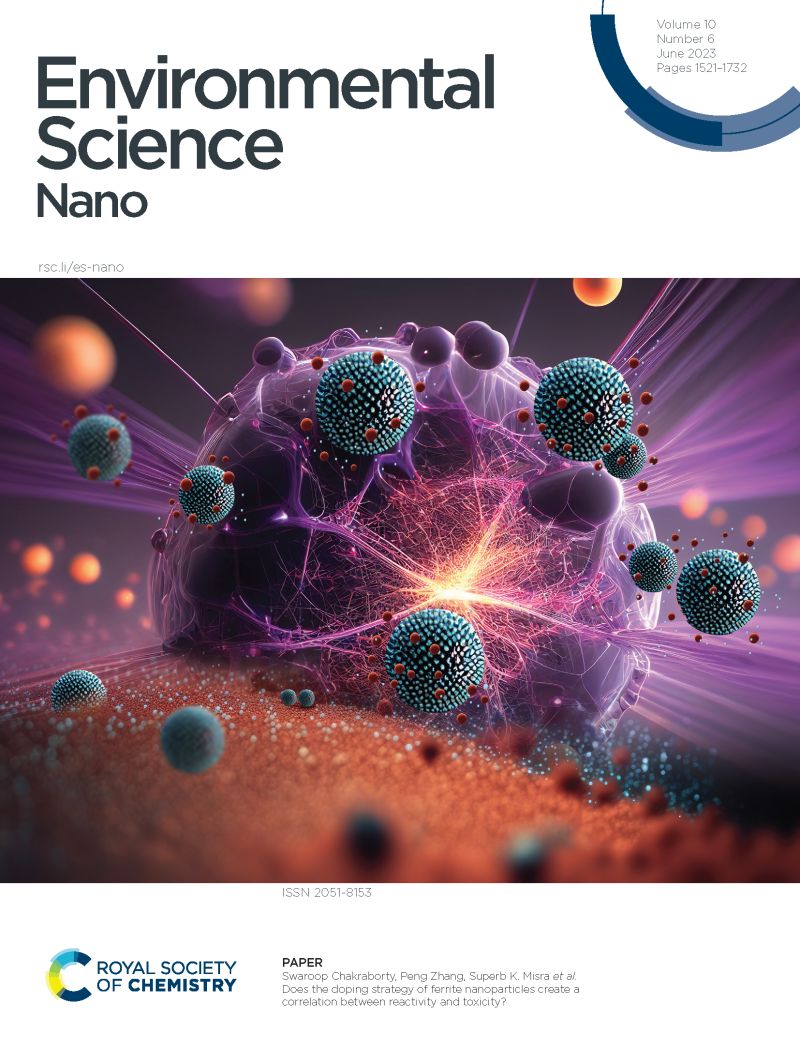Comparison of the effects of chemical surfactant and bio-surfactant on montmorillonite colloid-mediated transport of levofloxacin through saturated porous media
IF 5.8
2区 环境科学与生态学
Q1 CHEMISTRY, MULTIDISCIPLINARY
引用次数: 0
Abstract
The transport behavior of levofloxacin (LEV, a typical fluoroquinolone antibiotic) in aquifers may be affected by clay particles (e.g., montmorillonite colloids) and surfactants, which are widespread in aquatic environments. Little is known about the influence of different surfactants (e.g., chemical and bio-surfactants) on the LEV mobility in the presence of clay colloids. In this study, sodium dodecylbenzene sulfonate (SDBS) and rhamnolipid (Rha) were chosen as typical chemical surfactants and bio-surfactants, respectively. The combined roles of montmorillonite colloids and different surfactants on LEV mobility in saturated porous media under different pH conditions (5.0–9.0) were investigated. Generally, montmorillonite colloids promote LEV transport because of the colloids' high mobility and the montmorillonite binding capacity toward LEV. Meanwhile, the enhanced effects decreased with increasing pH because of the declined adsorption of LEV to colloids. Interestingly, colloid-facilitated transport of LEV was enhanced by the presence of surfactants. These observations mainly stem from the enhanced mobility of montmorillonite colloids and the increased binding abilities of colloids for LEV induced by surfactants (via the bridging effects of surfactants). Interestingly, compared with Rha, SDBS exhibited a superior effect on montmorillonite colloid-facilitated LEV transport. This is because more LEV is adsorbed onto clay colloids in the presence of SDBS owing to greater bridging effects and additional π–π stacking interactions. As a result, an increased amount of colloid-associated LEV may penetrate the columns. This study provides a fresh understanding of the diverse impacts of ubiquitous surfactants on colloid-mediated transport of antibiotics in subsurface environments.化学表面活性剂和生物表面活性剂对蒙脱土胶体介导左氧氟沙星在饱和多孔介质中的转运影响的比较
左氧氟沙星(LEV,一种典型的氟喹诺酮类抗生素)在含水层中的转运行为可能受到广泛存在于水生环境中的粘土颗粒(如蒙脱土胶体)和表面活性剂的影响。对于不同表面活性剂(如化学和生物表面活性剂)在粘土胶体存在下对LEV迁移率的影响知之甚少。本研究选择十二烷基苯磺酸钠(SDBS)和鼠李糖脂(Rha)分别作为典型的化学表面活性剂和生物表面活性剂。研究了不同pH(5.0 ~ 9.0)条件下,蒙脱土胶体和不同表面活性剂对饱和多孔介质中LEV迁移率的联合作用。由于蒙脱土胶体的高流动性和蒙脱土对LEV的结合能力,通常会促进LEV的运输。同时,随着pH的增加,LEV对胶体的吸附减少,增强效果减弱。有趣的是,表面活性剂的存在增强了胶体促进的LEV运输。这些观察结果主要源于蒙脱土胶体的流动性增强,以及表面活性剂诱导的胶体对LEV的结合能力增强(通过表面活性剂的桥接作用)。有趣的是,与Rha相比,SDBS在蒙脱土胶体促进的LEV运输中表现出更好的效果。这是因为在SDBS存在的情况下,由于更大的桥接效应和额外的π -π堆叠相互作用,更多的LEV被吸附到粘土胶体上。结果,增加的胶体相关的LEV可以穿透柱。这项研究为普遍存在的表面活性剂对抗生素在地下环境中胶体介导的转运的不同影响提供了新的认识。
本文章由计算机程序翻译,如有差异,请以英文原文为准。
求助全文
约1分钟内获得全文
求助全文
来源期刊

Environmental Science: Nano
CHEMISTRY, MULTIDISCIPLINARY-ENVIRONMENTAL SCIENCES
CiteScore
12.20
自引率
5.50%
发文量
290
审稿时长
2.1 months
期刊介绍:
Environmental Science: Nano serves as a comprehensive and high-impact peer-reviewed source of information on the design and demonstration of engineered nanomaterials for environment-based applications. It also covers the interactions between engineered, natural, and incidental nanomaterials with biological and environmental systems. This scope includes, but is not limited to, the following topic areas:
Novel nanomaterial-based applications for water, air, soil, food, and energy sustainability
Nanomaterial interactions with biological systems and nanotoxicology
Environmental fate, reactivity, and transformations of nanoscale materials
Nanoscale processes in the environment
Sustainable nanotechnology including rational nanomaterial design, life cycle assessment, risk/benefit analysis
 求助内容:
求助内容: 应助结果提醒方式:
应助结果提醒方式:


